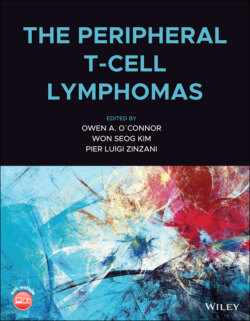Читать книгу The Peripheral T-Cell Lymphomas - Группа авторов - Страница 26
Immune Surveillance
ОглавлениеThe immune system perpetually eradicates the formation and progression of incipient neoplasia, and evading the immune control is one of the hallmarks of cancer. Two main mechanisms of immune escape may be employed. On the one hand, neoplastic cells can overexpress surface ligands such as PDL1, PDL2, which, after receptor engagement, result in anergy of tumor infiltrating lymphocytes. On the other hand, T and NK neoplastic cells may avoid immune recognition through the loss of class I CMH and or beta2 microglobulin alterations and CD58 anomalies. CD58 is a member of immunoglobulins superfamily which acts as a ligand for CD2 that allows activation of T and NK cells. Those alterations are found in several lymphomas, especially in diffuse large B‐cell lymphomas [58]. It is noteworthy that alterations in CMH and beta 2 microglobulin or CD58, impairing the recognition by T or NK cells have been described in ATLL [46] and PTCL‐NOS [53].
The efficacy of immunotherapy such anti‐PD1 or anti‐CTLA4 antibodies in several cancers also reinforces the importance of immune escape of neoplastic cells. However, targeting the immune system in PTCL is far more complex, as the neoplastic targets are T cells themselves, in which the TCR, co‐stimulation system and cytokines receptors may be functional. As mentioned above, structural variants in the 3′ UTR part of PDL1 have been reported in ATLL [9], ENKTL or other EBV‐related T‐ or NK‐cell lymphomas [10]. The 3′ UTR is a region allowing posttranscriptional regulation of mRNA level through action of microRNA or regulating proteins. These structural variants result in PDL1 overexpression, contributing to immune escape. It is noteworthy that relapsed/refractory ENKTL show a high response rate to anti‐PD1 therapy [59].
In CTCL, a gene fusion between CD28 and CTLA4 results in a chimeric receptor with the extracellular domain of CTLA4 and the intracellular domain of CD28 [60]. This CTLA4–CD28 fusion converts the negative inhibitory effect normally exerted by CTLA4 ligands expressed by reactive cells surrounding neoplastic T cells, into an activating signal driven by the intracellular CD28‐derived segment of the chimeric receptor. In this setting, deregulated signaling resulting from the structural change of the receptor, is not autonomous and exemplifies the cooperation between microenvironment and intrinsic changes in the neoplastic cells.
